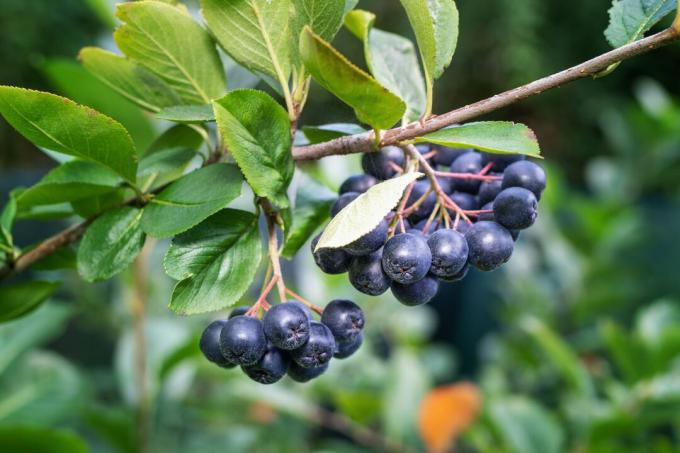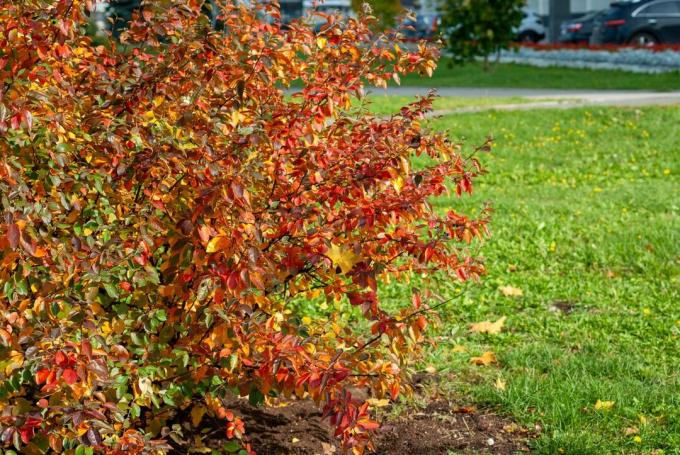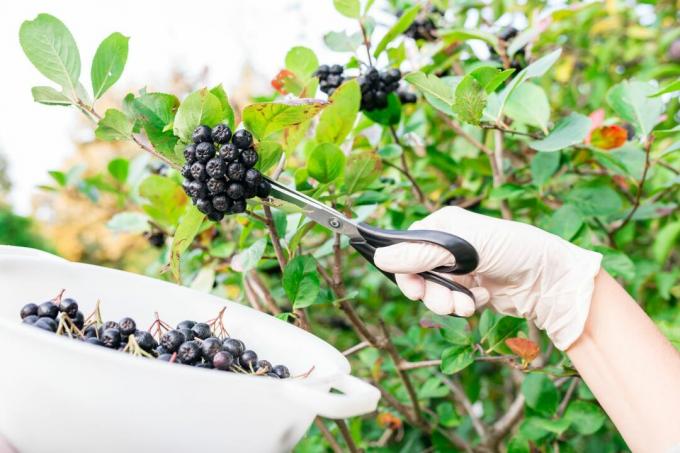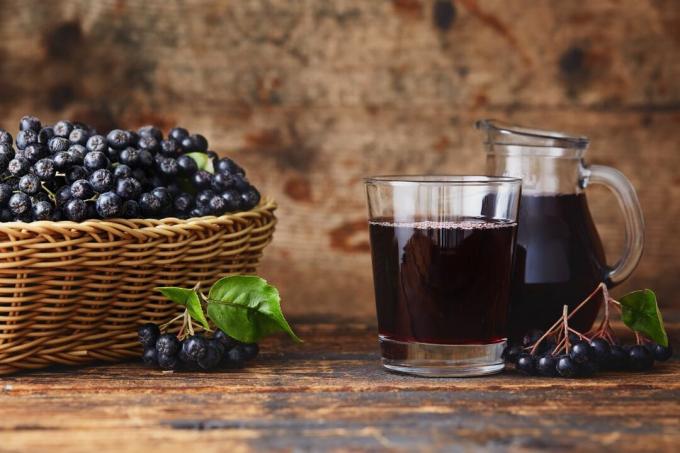The healthy chokeberry is trendy as a superfood and also brings a rich yield in the home garden. We give tips on location requirements and cultivation of aronia.

Health-conscious people know the chokeberry as a superfood in the form of juices or powder from health food stores and well-stocked organic shops. But healthy aronia can also be grown in our gardens and plenty of fruit can be harvested. We introduce you to the robust shrub and show you the most important steps from planting to harvesting and using the chokeberry.
contents
- Aronia: origin and characteristics
- Planting aronia: location and procedure
-
The most important maintenance measures
- Fertilize and water the aronia
- Choke chokeberry
- Diseases and pests on aronia
- Propagate aronia
- Harvesting aronia: timing and procedure
- Use and storage of aronia
- Are chokeberries poisonous?
Aronia: origin and characteristics
The chokeberry (Aronia) originally comes from North America and belongs to the rose family (Rosaceae). Around 1900, the vitamin-rich, healthy fruit was first improved for commercial fruit growing in Eastern Europe and planted in plantations. In the last few years we have also been growing the chokeberry for pharmaceutical purposes or the food trade more and more often. It is closely related to our local mountain ash or rowanberry (
Sorbus aucuparia) and can even cross with it. There are three species in the genus Aronia counted: The felty chokeberry (Aronia arbutifolia), the black chokeberry (Aronia melanocarpa) and the plum-leaved chokeberry (Aronia x prunifolia). An overview of these Aronia species and their varieties can be found in our special article.The chokeberry is a moisture-loving, loose, multi-shoot, mostly overhanging and hardy shrub up to two meters in height and width. The leaves of the aronia are ovate to elliptical in shape and shiny green. The shrub is a special ornament in autumn when the foliage turns wine-red. In May the flowering time of the white or pink-white chokeberry flowers, which sit together in umbels and are visited by numerous bees, begins.
Small fruits develop from them, which in their appearance are very similar to rowan berries or apples (Malus) in miniature format. From a botanical point of view, the term “chokeberry” is not correct, because the black “berries” are, strictly speaking, collective note fruits. However, the term berry has become commonplace. From mid-August the first chokeberry fruits, which then turn black-violet, can be harvested. They weigh 1 to 1.5 g each and have a deep red-purple flesh.

The taste of the aronia is tart-sweet and not everyone's cup of tea, which is why the chokeberry, which can also be eaten raw, is only offered in processed form. The rich aronia bushes can produce 10 to 17 kg of fruit in good years, but birds also love to nibble on them.
Planting aronia: location and procedure
Aronia bushes are adaptable and only thrive poorly on dry and at the same time calcareous soils. The optimal location for the chokeberry is in full sun to a little shady on slightly acidic, medium-heavy to slightly sandy and well water-storing, humus-rich soils. The pH should be between 5.8 and 6.5. Chokeberries form a flat, compact root system, which is why the quality of the topsoil is primarily decisive for them. Too heavy, clayey, but also too light, sandy soils can be made with a high-quality potting soil like ours Plantura organic tomato & vegetable soil, improved and thus made suitable for the aronia. The high compost content increases the water storage capacity and improves the soil structure. The high potassium requirement of the aronia berries is also covered by our nutrient-rich potting soil.
Due to its tolerable height, the aronia is suitable for underplanting tall trees, in groups or in individual positions in beds and large pots. They are ecologically very valuable, especially in wild fruit hedges, as the flowers and fruits serve as food for numerous insects and birds. The shrubs are best planted between October and the end of November, at the beginning of the winter dormancy. In this way, roots form first, which can then supply the new leaves with nutrients and water in the next spring. Even in early spring - beginning of March - you can still plant. In summer, however, you should water these shrubs regularly until they are well rooted. A layer of mulch helps to retain water and keep the pH in the slightly acidic range.
For hedges and dense group plantings, the planting distance for chokeberries is about 1 to 1.5 m, in individual positions 3 to 4 m. Loosen the soil extensively and work in some compost if necessary. Then dig a planting hole and put the aronia bush into it. It can also be planted a little deeper so that the branching of the trunk starts underground, as this will encourage branching at the base.
Plant aronia in a pot: To keep chokeberries in the bucket, the planter must be large enough and have a volume of at least 20 liters. The shallow root system requires a wide rather than deep pot. Good water drainage and a five centimeter high drainage layer made of expanded clay, sand and gravel prevent waterlogging. High-quality compost-based potting soil supports plant health and has been proven to promote root growth through the release of humic substances. Every two to three years - in spring - the chokeberry should be moved to a larger planter and filled with fresh soil. It is also worthwhile to apply a layer of mulch when keeping chokeberries in pots in order to maintain the moisture and the low pH value.

tip: The flowers appear before the ice saints and are very sensitive to frost. However, the aronia blooms for a full two weeks, which is why it is generally not endangered by late frost and is also suitable for locations where it is cold in spring.
Planting aronia: summary
- Location: Full sun to a little shady
- Soil: Medium-heavy to slightly sandy, good water-storing, humic with a slightly acidic pH value
- Time: October - end of November; at the beginning of March
- Plant spacing: 1 - 1.5 m for hedges and group plantings; 3 - 4 m in single position
- In the bucket: large planter (min. 20 l) and drainage layer
The most important maintenance measures
The undemanding chokeberry is a reward for gardening attentions with abundant flowering and good yield. Freshly planted, however, the shrubs do not tolerate competition. Therefore, weeds around and in the plant should be pulled out regularly. In the following you will find further tips for the most important care measures for aronia bushes.
Fertilize and water the aronia
You have to water the chokeberry regularly in the garden in the first two years after planting, until a sufficient number of roots have formed. Flowering and yield suffer from dry periods in summer and spring. Therefore, in this case, it is also worth watering older plants. When kept in pots, the chokeberry needs regular water replenishment, especially on hot summer days.
Chokeberries have a medium nutritional requirement and should always be replenished. With aronia in the bucket, regular fertilization is particularly important due to the limited soil supply. The ideal time to apply fertilizer is between leaf shoots and flowering, i.e. between April and May. A mainly organic slow release fertilizer like ours Plantura organic universal fertilizer, can be worked into the surface of the bed or mixed with the potting soil when repotting.
Choke chokeberry
Chokeberries are easy to cut. Most of the flowers and fruits are formed on five to six-year-old shoots, older branches bear significantly less. Seven to eight year old shoots should therefore be cut out in the winter months together with weak, thin new shoots - similar to Black currants (Ribes nigrum). Ideally, a chokeberry bush consists of equal parts from one to six year old branches. In this way, the shrub will be able to produce plenty of fruit every year in the future.
Diseases and pests on aronia
Chokeberries are robust shrubs and rarely become ill. The notifiable, threatening fire blight (Erwinia amylovora) and Powdery mildew (Erysiphaceae) can occur on aronia bushes. As pests are used every now and then Frost wrench (Operophtera) and mountain ash moths (Argyresthia conjugella) observed. The fruits of the aronia are particularly endangered by the infestation with the Cherry vinegar fly (Drosophila suzukii) and bird food.
Propagate aronia
Aronia can be propagated from seeds, cuttings and runners. Only the Hugin ’variety can be propagated in a true-to-seed manner, all other varieties can only be propagated vegetatively in a true-to-variety manner. The seeds of the aronia are Cold germthat only germinate after a prolonged cold stimulus.
Chokeberries naturally form runners every now and then and can easily be propagated that way. The runners are pricked from the mother plant with a spade and moved to a new location.
In summer, cuttings or cuttings are cut from young, not yet woody shoot tips. Fill a seed pot with a mixture of sand and nutrient-poor potting soil. The approximately 10 cm long cuttings are peeled off to the tip after cutting and inserted deep into the moistened soil mixture. In the following weeks, the light and moist aronia cuttings, kept at 15 to 20 ° C, will take root.

Harvesting aronia: timing and procedure
Depending on the variety, the harvest time begins in early to mid-August and lasts for about three weeks. You have to be quick when harvesting, because birds can empty entire bushes in a very short time. With a pair of secateurs, you cut off the fruits that are sitting together as a whole grape, wash them and then pluck the chokeberries from the stems. Since the juice stains strongly, we recommend wearing gloves. Few people enjoy the tart, sweet fruits in their raw state, which is why the fresh fruits are usually processed further.
Use and storage of aronia
Aronia berries remain firm and hard-skinned even when fully ripe. At 0 to 2 ° C, they can be stored in the refrigerator for up to four months. Frozen whole fruits can be stored for years and further processed if necessary. Aronia juice can be pressed from the healthy fruits. This is strongly coloring and is therefore added to dairy products, light juices, cocktails or liqueurs. The aromatic taste unfolds in aronia jams and jellies, but also in baked goods.
The fruits of the aronia can be dried at gentle temperatures of 50 to 60 ° C and retain most of their healthy ingredients. Especially vitamin C (137 mg per 100 g of fresh fruit), but also calcium and potassium are contained in the healthy aronia berries. The coloring polyphenols - the so-called anthocyanins - have an antioxidant effect and could thus reduce the risk of cancer. In folk medicine, the juice from the chokeberry is used to lower blood pressure and cholesterol levels.

Are chokeberries poisonous?
Ripe chokeberries can also be eaten raw and are completely harmless to humans and animals. As in apples and almonds, the kernels in the fruits of the aronia contain small amounts of amygdalin. When the kernels are bitten, the substance is released and converted into highly toxic hydrocyanic acid in the body. Cores swallowed undamaged and safely traversed the digestive tract without releasing amygdalin. 100 g of almond kernels contain about twice the amount of amygdalin than is found in 100 g of fresh aronia berries. In addition, it is hardly possible to chew all of the kernels, let alone consume this amount of tart and sour fruits. If the kernels are heated, a large part of the already low amygdalin content builds up. All processed aronia products are therefore completely safe to enjoy.
Do you already know that Hawthorn (Crataegus)? The genus Crataegus consists of other ecologically valuable bird nutrient trees, which inspire with bee-friendly flowers and a splendid autumn color.
